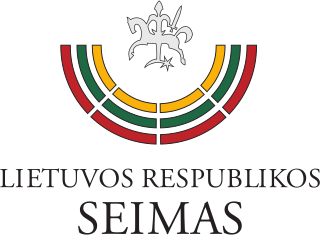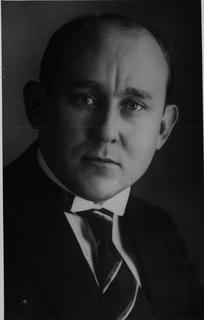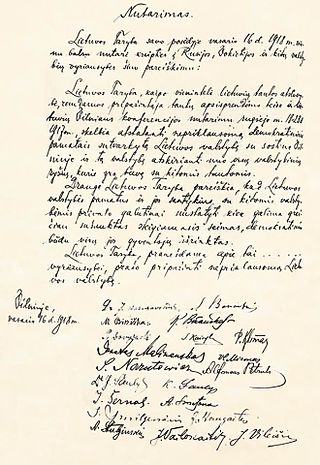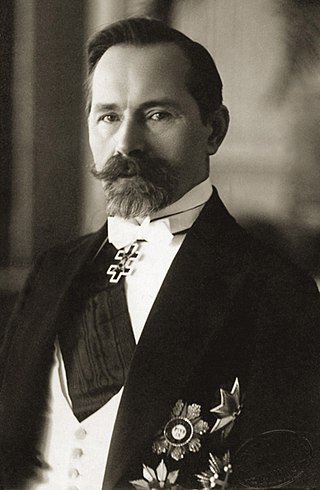
Aleksandras Stulginskis was the second President of Lithuania (1920–1926). Stulginskis was also acting President of Lithuania for a few hours later in 1926, following a military coup that was led by his predecessor, President Antanas Smetona, and which had brought down Stulginskis's successor, Kazys Grinius. The coup returned Smetona to office after Stulginskis's brief formal assumption of the Presidency.

Kazys Grinius was the third President of Lithuania, holding the office from 7 June 1926 to 17 December 1926. Previously, he had served as the fifth Prime Minister of Lithuania, from 19 June 1920 until his resignation on 18 January 1922. He was posthumously awarded the Lithuanian Life Saving Cross for saving people during the Holocaust and was recognised as a Righteous Among the Nations in 2016.

The Seimas of the Republic of Lithuania, or simply the Seimas, is the unicameral legislative body of the Republic of Lithuania. The Seimas constitutes the legislative branch of government in Lithuania, enacting laws and amendments to the Constitution, passing the budget, confirming the Prime Minister and the Government and controlling their activities.
The Constituent Assembly of Lithuania or Constituent Seimas was the first parliament of the independent state of Lithuania to be elected in a direct, democratic, general, secret election. The Assembly assumed its duties on 15 May 1920 and was disbanded in October 1922.

Mykolas Sleževičius was a Lithuanian lawyer, political and cultural figure, and journalist. One of the most influential figures in inter-war Lithuania, he served as the prime minister of Lithuania on three occasions. Taking the helm of the government at a difficult time in 1918 and again in 1919, Sleževičius has been credited with preparing Lithuania for the fights to come and for laying the foundations of the fledgling state.
In the history of Lithuania, the Council of Lithuania, after July 11, 1918, the State Council of Lithuania was convened at the Vilnius Conference that took place between 18 and 23 September 1917. The twenty men who composed the council at first were of different ages, social status, professions, and political affiliations. The council was granted the executive authority of the Lithuanian people and was entrusted to establish an independent Lithuanian state. On 16 February 1918, the members of the council signed the Act of Independence of Lithuania and declared Lithuania an independent state based on democratic principles. 16 February is celebrated as Lithuania's State Restoration Day. The council managed to establish the proclamation of independence despite the presence of German troops in the country until the autumn of 1918. By the spring of 1919, the council had almost doubled in size. The council continued its efforts until the Constituent Assembly of Lithuania first met on 15 May 1920.

Vytautas Petrulis was a Lithuanian politician, one of the main figures in the Lithuanian Christian Democratic Party, and an accountant. He is often nicknamed "the father of the Litas" as it was during his term as Minister of Finance that the Lithuanian litas was introduced.

Leonas Bistras was one of the most prominent Lithuanian politicians of the interwar period. A Christian Democrat, he was in 1925 appointed Prime Minister of Lithuania. Bistras also headed the ministries of education, defense and foreign affairs in several different governments throughout the 1920s and 1930s and twice served as the speaker of the Lithuanian parliament, the Seimas. After the 1926 Lithuanian coup d'état and the subsequent fall of parliamentary democracy, Bistras led the Christian Democrats and, despite persecution, acted as an outspoken leader of the opposition to the authoritarian President Antanas Smetona.

Vladas Mironas was a Lithuanian Catholic priest and politician. He was one of the twenty signatories of the Act of Independence of Lithuania and served as the Prime Minister of Lithuania from March 1938 to March 1939.

The Act of Independence of Lithuania or the Act of February 16th, also the Lithuanian Resolution on Independence, was signed by the Council of Lithuania on February 16, 1918, proclaiming the restoration of an independent State of Lithuania, governed by democratic principles, with Vilnius as its capital. The Act was signed by all twenty representatives of the Council, which was chaired by Jonas Basanavičius. The Act of February 16 was the result of a series of resolutions on the issue, including one issued by the Vilnius Conference and the Act of January 8. The path to the Act was long and complex because the German Empire exerted pressure on the Council to form an alliance. The Council had to carefully maneuver between the Germans, whose troops were present in Lithuania, and the demands of the Lithuanian people.

The signatories of the Act of Independence of Lithuania were the twenty Lithuanian men who signed the Act of Independence of Lithuania on February 16, 1918. The signatories were elected to the Council of Lithuania by the Vilnius Conference in September 1917 and entrusted with the mission of establishing an independent Lithuanian state. The proclaimed independence was established only in late 1918, after Germany lost World War I and its troops retreated from Lithuanian territory. What followed was a long process of building the state, determining its borders, and gaining international diplomatic recognition. The signatories succeeded in their mission and independent Lithuania survived until the Soviet Union occupied the state on June 15, 1940.

The Great Seimas of Vilnius was a major assembly held on December 4 and 5, 1905 in Vilnius, Lithuania, then part of the Russian Empire, largely inspired by the Russian Revolution of 1905. It was the first modern national congress in Lithuania and dealt primarily not with the social issues that sparked the revolution, but with national concerns. Over 2,000 participants took part in the Seimas. The assembly made the decision to demand wide political autonomy within the Russian Empire and achieve this by peaceful means. It is considered an important step towards the Act of Independence of Lithuania, adopted on February 16, 1918, by the Council of Lithuania, as the Seimas laid the groundwork for the establishment of an independent Lithuanian state.

The 1926 Lithuanian coup d'état was a military coup d'état in Lithuania that replaced the democratically elected government with a nationalist regime led by Antanas Smetona. The coup took place on 17 December 1926 and was largely organized by the military; Smetona's role remains the subject of debate. The coup brought the Lithuanian Nationalist Union, the most conservative party at the time, to power. Previously it had been a fairly new and insignificant nationalistic party. By 1926, its membership reached about 2,000 and it had won only three seats in the parliamentary elections. The Lithuanian Christian Democratic Party, the largest party in the Seimas at the time, collaborated with the military and provided constitutional legitimacy to the coup, but accepted no major posts in the new government and withdrew in May 1927. After the military handed power over to the civilian government, it ceased playing a direct role in political life.
First Seimas of Lithuania was the first parliament (Seimas) democratically elected in Lithuania after it declared independence on February 16, 1918.

The Third Seimas of Lithuania was the third parliament (Seimas) democratically elected in Lithuania after it declared independence on 16 February 1918. The elections took place on 8–10 May 1926. For the first time the Lithuanian Christian Democratic Party were forced to remain in opposition. The coalition government made some unpopular decisions and was sharply criticized. Regular Seimas work was interrupted by a military coup d'état in December 1926 when the democratically elected government was replaced with the authoritarian government of Antanas Smetona and Augustinas Voldemaras. The Third Seimas was dissolved on 12 March 1927 and new elections were not called until 1936.
The Lithuanian Christian Democratic Party was a Christian-democratic political party in Lithuania.

Parliamentary elections were held in Lithuania on 10 and 11 October 1922, electing 78 members of the First Seimas. They were the first elections held in Lithuania under the 1922 constitution, which had been adopted by the Constituent Assembly on 1 August 1922.

The Lithuanian Catholic Federation Ateitis is a youth organization in Lithuania uniting Catholic-minded schoolchildren, university students, and alumni. Ateitis is a member of the Fimcap umbrella group of Catholic youth organizations. Members of the Ateitis Federation are known as ateitininkai.

The Lithuanian Nationalist Union, also known as the Nationalists, was the ruling political party in Lithuania during the authoritarian regime of President Antanas Smetona from 1926 to 1940. The party was established in 1924 but was not popular. It came to power as a result of the December 1926 military coup. From 1927 to 1939, the Council of Ministers included only members of the LTS. In 1936, other parties were officially disbanded, leaving LTS the only legal party in the country. At the end of the 1930s new members started bringing in new ideas, right wing and closer to Italian Fascism. The party was disestablished after the Soviet occupation of Lithuania in June 1940. A party of the same name was reestablished in 1990 and claims to be the successor of the interwar LTS.
The Workers' Group of Lithuania was a front organization of the Communist Party of Lithuania that participated in the elections to the First and Second Seimas of Lithuania in 1922 and 1923. Members of this group became known as Kuopininkai ("groupers").














